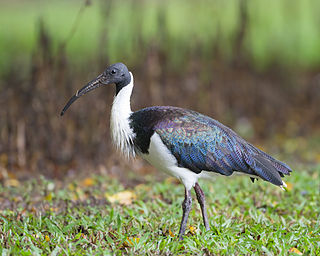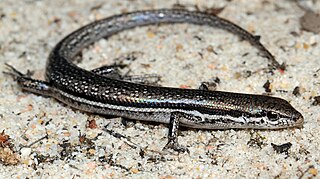
Skinks are lizards belonging to the family Scincidae, a family in the infraorder Scincomorpha. With more than 1,500 described species across 100 different taxonomic genera, the family Scincidae is one of the most diverse families of lizards. Skinks are characterized by their smaller legs in comparison to typical lizards and are found in different habitats except arctic and subarctic regions.

The Solomon Islands skink, also known as prehensile-tailed skink, monkey-tailed skink, giant skink, zebra skink, and monkey skink, is an arboreal species of skink endemic to the Solomon Islands archipelago. It is the largest known extant species of skink.

The central bearded dragon, also known as the inland bearded dragon, is a species of agamid lizard found in a wide range of arid to semiarid regions of eastern and central Australia.

Anolis carolinensis or green anole is a tree-dwelling species of anole lizard native to the southeastern United States and introduced to islands in the Pacific and Caribbean. A small to medium-sized lizard, the green anole is a trunk-crown ecomorph and can change its color to several shades from brown to green.

The western skink is a species of small, smooth-scaled lizard with relatively small limbs. It measures about 100 to 210 mm in total length. It is one of seven species of lizards in Canada. They spend much of their day basking in the sun. Their diet ranges widely, including spiders and beetles. Western skinks will bite if grasped and will flee if they feel threatened. It is a common but secretive species whose range extends from southern British Columbia and throughout Washington, Oregon, Nevada, Utah, Idaho, and Wyoming and into western Montana and northern Arizona and Missouri. They can also live in some areas of Texas It is widespread in northern California but primarily restricted to the coast in central and southern California. Found in a variety of habitats, this lizard is most common in early successional stages or open areas of late successional stages. Heavy brush and densely forested areas are generally avoided. Western skinks are found from sea level to at least 2,130 m (7,000 ft). This diurnal reptile is active during the warm seasons.

The (American) five-lined skink is a species of lizard in the family Scincidae. The species is endemic to North America. It is one of the most common lizards in the eastern U.S. and one of the seven native species of lizards in Canada.

The green tree python, is a species of snake in the family Pythonidae. The species is native to New Guinea, some islands in Indonesia, and the Cape York Peninsula in Australia. First described by Hermann Schlegel in 1872, it was known for many years as Chondropython viridis. As its common name suggests, it is a bright green snake that can reach a total length of 2 m (6.6 ft) and a weight of 1.6 kg (3.5 lb), with females slightly larger and heavier than males. Living generally in trees, the green tree python mainly hunts and eats small reptiles and mammals. It is a popular pet, and numbers in the wild have suffered with large-scale smuggling of wild-caught green tree pythons in Indonesia. Despite this, the green tree python is rated as least concern on the IUCN Red List of endangered species.

The cat gecko is a species of gecko found in Indonesia, Malaysia, Singapore, Cambodia and Thailand. It is the only species within the genus Aeluroscalabotes. It is commonly called the cat gecko because of its habit of curling up with its tail around itself when it sleeps, similar to a cat.

The pig-nosed turtle, also known as the Fly River turtle, the pitted-shelled turtle, and the Warrajan is a species of turtle which is native to northern Australia and southern New Guinea. It is the only living member of the genus Carettochelys and family Carettochelyidae, a family which also contains many fossil species with their closest relatives being the softshell turtles.

The straw-necked ibis is a bird of the ibis and spoonbill family Threskiornithidae. It can be found throughout Australia, New Guinea, and parts of Indonesia. Adults have distinctive straw-like feathers on their necks.
Plasmodium tribolonoti is a parasite of the genus Plasmodium.
Plasmodium gracilis is a parasite of the genus Plasmodium.
The giant spiny skink or Poncelet's helmet skink is a species of lizard in the family Scincidae. The species is endemic to the Solomon Islands.

The Jonquil parrot(Aprosmictus jonquillaceus) is a species of bird in the Psittaculidae family with two subspecies, Aprosmictus jonquillaceus jonquillaceus and Aprosmictus jonquillaceus wetterensis. It is a large, long-tailed green parrot with an orange bill and a wing patch which red in males and yellow in females. It is visible when a bird is perched and in flight. The juvenile looks like a female but lacks a wing patch.
A circulus is a rarely occurring reptilian social group where there is interaction and personal exchange between individuals. Members will often protect and defend young, even if not of direct genetic linkage. Circulus is a Latin based term; one definition of the word is "a social gathering or circle company". Most reptiles are indifferent socially to each other as adults or to offspring.

Dumeril's monitor is a species of lizard in the family Varanidae. The species is endemic to Southeast Asia.

An exotic pet is a pet which is relatively rare or unusual to keep, or is generally thought of as a wild species rather than as a domesticated pet. The definition varies by culture, location, and over time—as animals become firmly enough established in the world of animal fancy, they may no longer be considered exotic.
Petronella Johanna Nelly de Rooij was a Dutch zoologist and herpetologist.
Schmidt's helmet skink, also known commonly as Schmidt's crocodile skink, is a species of lizard in the family Scincidae. The species is endemic to Guadalcanal in the Solomon Islands.

The shrubland Morethia skink is a species of skink endemic to Australia, of the family Scincidae, found in New South Wales, South Australia, Victoria (Australia), Western Australia in Australia.















